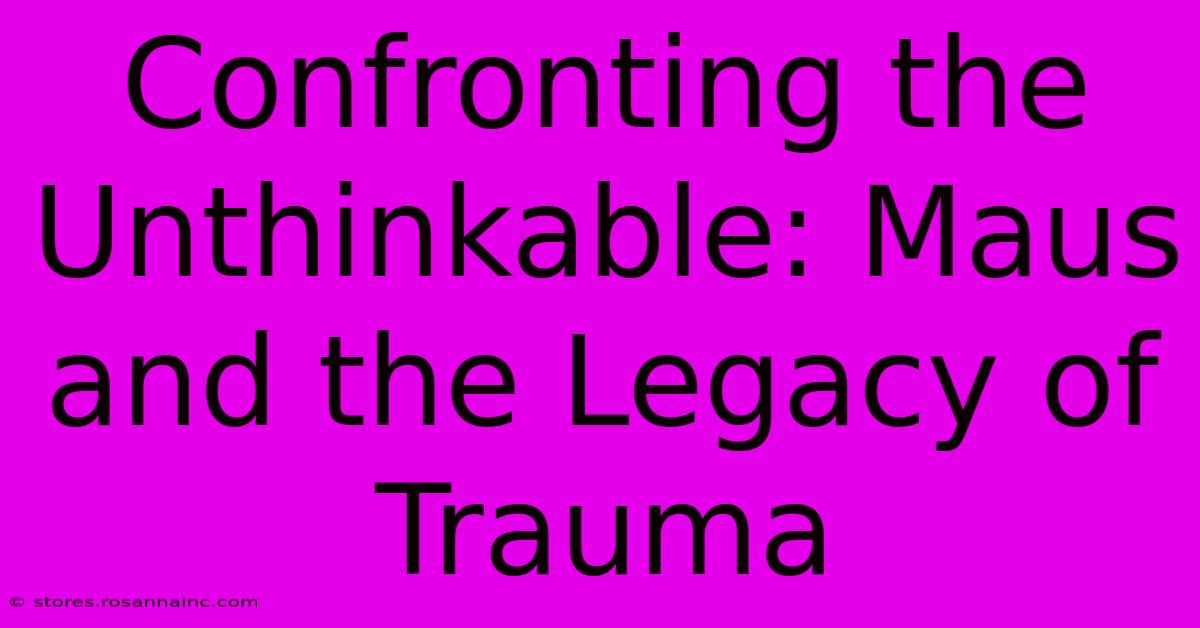Confronting The Unthinkable: Maus And The Legacy Of Trauma

Table of Contents
Confronting the Unthinkable: Maus and the Legacy of Trauma
Art Spiegelman's Maus, a Pulitzer Prize-winning graphic novel, isn't just a powerful narrative of the Holocaust; it's a profound exploration of intergenerational trauma and its lingering impact. This groundbreaking work transcends the limitations of traditional historical accounts, offering a deeply personal and emotionally resonant examination of the unspeakable horrors of the Nazi regime and their enduring consequences. Understanding Maus' significance requires appreciating its innovative approach to storytelling, its unflinching portrayal of trauma, and its lasting legacy in the way we understand and discuss the Holocaust.
The Power of Visual Storytelling
Maus’s unique strength lies in its unconventional narrative structure. By depicting Jews as mice and Nazis as cats, Spiegelman employs a striking visual metaphor that both distances and intensifies the narrative. This symbolic representation allows him to tackle the emotionally overwhelming subject matter with a level of detachment that facilitates engagement, while simultaneously highlighting the dehumanization inherent in the Holocaust. The animalistic imagery isn't merely stylistic; it underscores the systematic stripping away of humanity inflicted upon the victims. This innovative approach transforms a historically weighty topic into a surprisingly accessible yet deeply moving experience.
Beyond the Metaphor: Exploring the complexities of father-son relationships
The graphic novel isn't solely focused on the Holocaust itself. It's equally, perhaps even more profoundly, a story about the complex relationship between Spiegelman and his father, Vladek. The narrative jumps between Vladek's harrowing experiences in Auschwitz and Spiegelman's struggles to understand and process his father's trauma. This intergenerational dialogue forms the core of the story, revealing how trauma transcends generations and continues to shape family dynamics. We see Vladek's survival tactics – his shrewdness and sometimes even his ruthlessness – as both admirable and deeply disturbing. The reader witnesses the strain on their relationship, the silences, and the difficulties in communication that arise from the weight of unspoken suffering.
The Unflinching Depiction of Trauma
Maus doesn't shy away from the brutality of the Holocaust. It depicts the systematic dehumanization, the physical suffering, and the psychological torment endured by its victims with unflinching honesty. However, the power of the narrative comes not from gratuitous depictions of violence, but from its sensitive and nuanced portrayal of the psychological scars that endure long after the physical wounds have healed. We see the lasting effects of trauma on Vladek, manifested in his anxieties, his parsimony, and his sometimes difficult personality. Spiegelman's willingness to portray these complexities humanizes both the survivor and the legacy of trauma he inherited.
The lingering shadows: Intergenerational trauma and its impact
The graphic novel powerfully demonstrates how trauma is not merely a personal experience; it is also a legacy passed down through generations. Spiegelman grapples with his own struggles to understand and process his father's experiences, highlighting the complexities and challenges of bearing witness to historical trauma. This exploration moves beyond a simple historical account to a deeper investigation of the human cost of genocide and its ongoing effects on families and individuals. The intergenerational aspect of trauma is central to Maus' lasting impact, prompting reflection on how we, as individuals and as a society, confront and address the lasting consequences of historical atrocities.
The Legacy of Maus
Maus remains a vital and relevant work today. Its innovative approach to storytelling, its unflinching portrayal of trauma, and its exploration of intergenerational relationships continue to resonate with readers across generations. The graphic novel has transformed the way we understand and discuss the Holocaust, prompting crucial conversations about memory, trauma, and the ongoing need to confront and learn from the atrocities of the past. Its legacy extends beyond the specific historical context, offering a powerful framework for understanding the enduring impact of trauma in all its forms.
Keywords: Maus, Art Spiegelman, Holocaust, graphic novel, intergenerational trauma, trauma, historical fiction, Pulitzer Prize, memory, father-son relationship, visual storytelling, Nazi Germany, Auschwitz, legacy of trauma, psychological trauma, dehumanization, narrative structure, survivor's guilt, Holocaust literature, Jewish history, World War II.

Thank you for visiting our website wich cover about Confronting The Unthinkable: Maus And The Legacy Of Trauma. We hope the information provided has been useful to you. Feel free to contact us if you have any questions or need further assistance. See you next time and dont miss to bookmark.
Featured Posts
-
Raja Ampat Indonesias Hidden Paradise Awaits
Feb 10, 2025
-
The Power Of A Wake Healing And Closure After Loss
Feb 10, 2025
-
Is The 605 Area Code Right For Your Business Find Out Now
Feb 10, 2025
-
No Te Pierdas Posiciones Al Rojo Vivo En La Liga Nacional
Feb 10, 2025
-
Hadestown Explained Unpacking The Myth And The Musical
Feb 10, 2025
